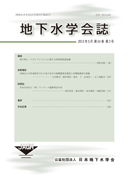All issues

Volume 32 (1990)
- Issue 4 Pages 201-
- Issue 3 Pages 139-
- Issue 2 Pages 71-
- Issue 1 Pages 1-
Volume 32, Issue 1
Displaying 1-7 of 7 articles from this issue
- |<
- <
- 1
- >
- >|
-
[in Japanese], [in Japanese], J.C. van DAM1990Volume 32Issue 1 Pages 1-4
Published: February 28, 1990
Released on J-STAGE: December 11, 2012
JOURNAL FREE ACCESSDownload PDF (520K) -
Koji KIMURA1990Volume 32Issue 1 Pages 5-16
Published: February 28, 1990
Released on J-STAGE: December 11, 2012
JOURNAL FREE ACCESSThe tuffaceous-mudstone is softened by chemical weathering and causes to collapse or landslide, in the Kobe Group of the Sanda basin, Hyogo prefecture. Additionally some high sodium bicarbonate groundwaters occur in this area. Author describes formation mechanism of groundwater including sodium bicarbonate and considered the relation between chemical nature of water and landslides.
The Kobe Group investigated is composed mainly of tuffaceous-mudstone, sandstone and tuff. Among them the tuffaceous-mudstone regulates the chemical quality of groundwater. The tuffaceousmudstone contains both montmorillonite adsorbing exchangeable sodium ion and minor amount of calcium carbonate. Although calcium carbonate has very low solubility itself, in the case of coexistence with sodium-montmorillonite, dissolved calcium ion exchanges for sodium ion, then solubility equilibrium of calcium carbonate breaks. Consequently chemical nature of water becomes high sodium bicarbonate type and alkaline. The more exchangeable cation is abundant in exchangeable sodium, the more the solution becomes high concentration in bicarbonate.
In the Kobe Group, when the tuffaceous-mudstone which adsorbs exchangeable sodium ion highly reacts with rainwater or groundwater to generate high sodium bicarbonate water in high concentration, and as a results calcium carbonate in the tuffraceous-mudstone may solve effectively.
Under these conditions, because of existence of such high salt water and alkaline water, montmorillonite may be produced newly. Therefore tuffaceous-mudstone is softened with water and causes to collapse or landslide.View full abstractDownload PDF (1425K) -
Kikugawa Basin, Shizuoka Prefecture, Central JapanTakemasa ISHII, Masaya YASUHARA, Kazuo KURODA1990Volume 32Issue 1 Pages 17-26
Published: February 28, 1990
Released on J-STAGE: December 11, 2012
JOURNAL FREE ACCESSMeasurements of discharge and electric conductivity (3lsites) and water quality survey (15sites) were carried out in a dry season in the Kikugawa Basin, Shizuoka Prefecture, of which area is mostly composed of the Neogene muddy sedimentary rocks. The rocks are lithologically divided into three groups, namely the Kurami, Sagara and Kakegawa Groups in ascending order, which mainly consist of mudstone and alternating beds of sandstone and mudstone. The Neogene strata are unconformably overlain by the Quaternary Soga Group, Ogasa and Makinohara Gravels, river terrace deposits and Alluvium.
The discharge and the electric conductivity at the sites measured twice are inversely proportionate to each other (See Table 1). The inverse proportion is roughly formed between the specific discharge and the electric conductivity as shown in Fig.3. The specific discharge of the surveyed 31 sites is calculated as 5.42 1/sec/km2, which is slightly less than the average specific discharge of the Kiku River during a dry season (6.71/sec/km 2) recorded at the Kamo Observation Station for the past 32 years (Ministry of Construction,1988). It seems that the specific discharge and the electric conductivity are particularly related to each other, with reference to the geological setting of catchment areas (See Fig.3).
Water samples are rich in Ca2+ and SO42- in general and some of them contain high density of NO3- (See Table 2, Figs.4 and 5). These dissolved components are possibly due to artificial fertilizers and agricultural medicines used in farm lands.View full abstractDownload PDF (1157K) -
[in Japanese], [in Japanese], [in Japanese]1990Volume 32Issue 1 Pages 27-34
Published: February 28, 1990
Released on J-STAGE: December 11, 2012
JOURNAL FREE ACCESSDownload PDF (986K) -
[in Japanese], [in Japanese]1990Volume 32Issue 1 Pages 35-40
Published: February 28, 1990
Released on J-STAGE: December 11, 2012
JOURNAL FREE ACCESSDownload PDF (862K) -
[in Japanese]1990Volume 32Issue 1 Pages 41-52
Published: February 28, 1990
Released on J-STAGE: December 11, 2012
JOURNAL FREE ACCESSDownload PDF (1397K) -
[in Japanese]1990Volume 32Issue 1 Pages 53-60_1
Published: February 28, 1990
Released on J-STAGE: December 11, 2012
JOURNAL FREE ACCESSDownload PDF (13465K)
- |<
- <
- 1
- >
- >|